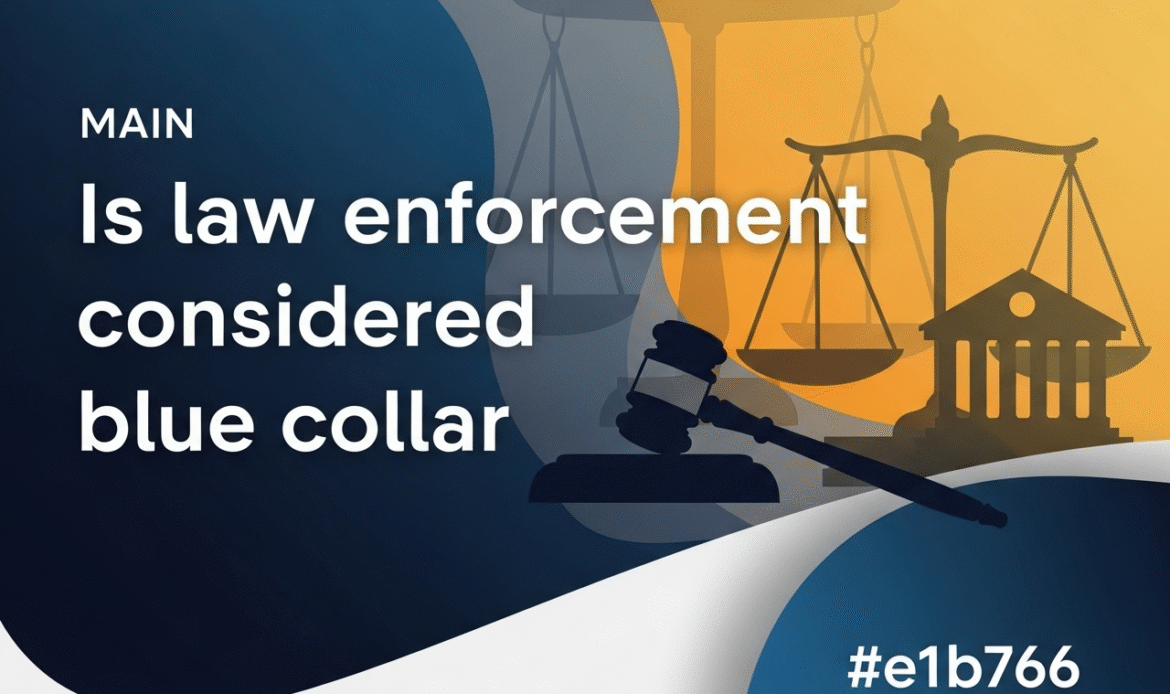Law enforcement officers stand at the heart of public safety. They patrol, respond to emergencies, and enforce laws that protect communities. Their work involves both physical challenges and intellectual responsibilities.
Many debates continue over whether their job should be labeled as blue collar, white collar, or something in between. In this article, you will learn the origins of the term blue collar, how police work fits or conflicts with this definition, and why understanding their classification matters in society today.
Defining Blue-Collar Work
The term “blue collar” originated in the early 20th century. Workers in trades and industry often wore blue uniforms to mask dirt and grease. Blue-collar jobs typically involve physical or manual labor. Roles include construction, factory, mining, and repair work. Most are paid hourly and have strong union representation.
Blue-collar jobs are often viewed as hands-on, practical, and labor-intensive. Over time, however, the scope has shifted. Many blue-collar roles now require specialized skills and certifications. Wages can be competitive with white-collar salaries, showing how outdated stereotypes no longer reflect today’s reality.
White-Collar Contrast
White-collar jobs describe professional, office-based work. These jobs rely heavily on academic education, administrative responsibilities, and strategic decision-making. Employees in this category often wear formal clothing, hence the “white collar” term. Roles include doctors, accountants, managers, and lawyers.
They are usually salaried, work predictable hours, and spend more time on paperwork than physical labor. While law enforcement shares some of these elements, such as reporting and courtroom testimony, its heavy reliance on physical duties makes it distinct. The profession cannot be boxed fully into this category, even though it borrows aspects of it.
Law Enforcement’s Physical Demands
Police officers often engage in activities that demand stamina and resilience. Patrolling streets, managing riots, conducting arrests, and responding to emergencies require physical readiness. Officers must also undergo fitness training to maintain capability.
This physical dimension is why many classify law enforcement as blue collar. These duties place them closer to construction workers or firefighters than to accountants. Yet the job involves more than physical strength. Officers also analyze data, interview witnesses, and present cases. Still, the reliance on physical presence and readiness strongly links the role to blue-collar traditions.
Training and Education Pathways
Blue-collar jobs often start with trade schools or apprenticeships. Law enforcement follows a similar model. Police academies train recruits in defensive tactics, firearm use, and emergency responses. Some departments require a college education, but many accept candidates with only a high school diploma.
Advanced positions, such as federal agents or detectives, may call for higher degrees. Ongoing training in technology, cybercrime, and crisis management reflects how the field adapts to modern challenges. This layered education mirrors both vocational and professional tracks, making the career path hybrid in nature, bridging blue-collar and white-collar expectations.
Compensation and Job Benefits
The U.S. Bureau of Labor Statistics reported a median annual wage of about $70,000 for police officers in 2023. This figure surpasses earnings in many traditional blue-collar sectors. Pay structures vary. Officers often receive salaries but also earn overtime and hazard pay.
Benefits include pensions, health coverage, and paid leave. Such packages align more with structured government jobs than hourly wage labor. However, the inclusion of union negotiations, overtime dependency, and shift-based work connect policing back to blue-collar roots. Their pay demonstrates how the job cuts across outdated categories.
Unions and Collective Power
Union membership is a defining blue-collar trait. Law enforcement officers commonly belong to unions or fraternal organizations. These groups negotiate for wages, benefits, and working conditions. They provide legal defense in disputes and protect members during disciplinary actions. The influence of police unions is particularly strong in shaping labor rights.
This connection to collective bargaining places officers closer to construction workers, electricians, and other blue-collar groups. Yet, the profession also deals with administrative hierarchies and governmental oversight, showing the dual identity of law enforcement as both labor-intensive and institutionally professional.
The Hybrid Reality
Law enforcement does not fit neatly into one collar category. Officers split their time between the streets and the office. They enforce laws, conduct investigations, and testify in court. This mix of duties requires physical, mental, and administrative skills.
Technology further adds to the complexity. Officers now use body cameras, digital forensics, and data analysis tools. These responsibilities echo both blue-collar and white-collar tasks. The profession is best described as hybrid, blending hands-on duties with professional-level responsibilities. Recognizing this balance allows society to see officers beyond outdated definitions.
Public Identity and Perception
The public largely perceives law enforcement as blue collar because of its visible, uniformed presence. Officers on patrol symbolize discipline, order, and service. Media portrayals, however, often highlight investigative brilliance or legal processes, suggesting white-collar traits. This dual perception shapes how society values officers.
Some embrace the blue-collar identity, viewing it as a sign of grit and sacrifice. Others emphasize the strategic, policy-driven side of the role. These mixed perceptions contribute to ongoing debates, revealing that classification is not just about work duties but also about how society views authority.
Modern Challenges
Recent years have introduced challenges that push law enforcement further into hybrid territory. Officers face complex issues like cybercrime, terrorism, and mental health crises. These require more than physical enforcement; they demand analysis, technology use, and advanced strategy.
Community policing initiatives also emphasize empathy, negotiation, and communication. These are not traditional blue-collar skills but professional competencies. At the same time, the core of the job remains physical. The balance between enforcing laws on the street and navigating modern complexities shows why labeling law enforcement is increasingly difficult under old models.
Why Classification Matters
The debate about whether law enforcement is blue collar matters for more than semantics. It affects recruitment, policy, and pay structures. If classified strictly as blue collar, officers may be undervalued for their professional responsibilities.
If seen only as white collar, the physical risks may be ignored. Acknowledging law enforcement as hybrid validates both aspects. It highlights the risks and the intellectual demands. Policymakers, unions, and communities must understand this dual identity to ensure fair treatment and effective support for officers. Classification shapes how careers develop and how officers are respected in society.
Specialized Roles in Law Enforcement
Modern law enforcement is not limited to patrol work. Specialized units handle tasks that demand unique skills. Cybercrime divisions investigate hacking, online fraud, and digital exploitation. Forensics teams analyze crime scenes using advanced science and technology. K-9 units deploy trained dogs for drug detection and search operations.
SWAT teams manage high-risk interventions such as hostage rescues or armed standoffs. Each specialty requires additional training and expertise, proving that law enforcement stretches far beyond traditional field patrol. These roles highlight how the profession incorporates both technical and tactical capabilities.
Technology’s Expanding Role
Technology shapes how officers operate. Body cameras provide accountability and evidence for investigations. Drones assist in surveillance during emergencies and search missions. Digital databases track criminal histories, improving efficiency in background checks.
Predictive policing software uses data to allocate resources where crime is more likely. These tools require officers to learn systems that blend IT skills with fieldwork. The adoption of technology moves policing further into professional territory while keeping its operational, blue-collar foundation intact.
The balance between physical enforcement and digital management shows how the job continues to evolve.
Career Advancement Opportunities
Many blue-collar jobs have clear pathways for skill growth but limited vertical advancement. Law enforcement offers more structured career ladders. Officers can progress to detectives, sergeants, lieutenants, or chiefs.
Each step adds administrative and leadership responsibilities. Higher ranks demand strategic planning, policy implementation, and management of personnel. The shift from field work to leadership mirrors the transition from blue-collar to white-collar characteristics within the same profession.
This structure makes law enforcement unique compared to traditional blue-collar roles, where promotions often lead to more physical tasks rather than leadership.
Global Comparisons
Different countries treat law enforcement classification differently. In the United States, the debate leans toward a hybrid view.
In Europe, police officers are often considered civil servants, aligning them closer to professional white-collar roles. In developing nations, law enforcement is more aligned with blue-collar identity due to limited formal education requirements and heavier reliance on physical presence.
These international differences show how culture and governance shape occupational identity. Classification is not universal but influenced by national context, pay structures, and training expectations.
Community Engagement Responsibilities
Policing today requires strong community engagement. Officers lead workshops in schools, build relationships with local groups, and mediate neighborhood disputes. These functions are not purely physical but social.
They demand communication, empathy, and negotiation skills. Community trust depends on these softer abilities, which are rarely linked with blue-collar work. Instead, they resemble professional competencies found in social work or counseling.
Adding this responsibility to the role further complicates classification. It reinforces how policing combines operational enforcement with civic leadership and community service.
Legal and Ethical Dimensions
Police officers operate under strict legal frameworks. Every arrest, search, or use of force is bound by law. Officers must understand constitutional rights, criminal statutes, and court procedures. This legal knowledge is essential to avoid liability and ensure fairness.
While the physical aspects of the job point to blue-collar, this legal side emphasizes professional expertise. Officers also face ethical dilemmas that require judgment and accountability. Balancing rights with enforcement demonstrates the intellectual load officers carry, distancing them from purely manual labor definitions.
The Psychological Burden
Another dimension often overlooked in classification is psychological strain. Officers experience trauma, stress, and long-term emotional challenges. Dealing with violent crimes, accidents, or high-pressure incidents impacts mental health. Departments increasingly provide counseling and resilience programs.
These stresses resemble challenges faced in high-responsibility professions rather than traditional blue-collar jobs. The need for psychological endurance adds a dimension beyond physical risk. Officers are expected to remain rational, fair, and composed under extreme conditions, highlighting their professional-level responsibilities alongside physical duties.
Conclusion
Law enforcement cannot be confined to outdated categories. The profession contains the physicality of blue-collar work and the analytical tasks of white-collar jobs. Officers walk a line between labor and professionalism, reflecting a hybrid career identity.
The modern role demands recognition for both its physical and intellectual weight. Rather than forcing law enforcement into one collar, it is more accurate to see it as a bridge. This perspective honors the sacrifices officers make and the skills they apply daily to protect society.
Robert Stewart is a seasoned law blog writer with a passion for translating complex legal concepts into accessible, informative content. With a keen eye for detail and a knack for storytelling, Robert crafts engaging articles that educate and empower readers in the realm of law.
Drawing upon his extensive experience in the legal field, Robert brings a wealth of knowledge to his writing, covering a diverse range of topics including personal injury, family law, criminal defense, and more. His articles combine thorough research with clear, concise language, making them valuable resources for both legal professionals and laypeople alike.


